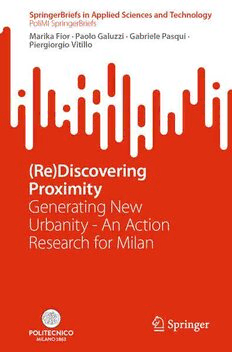
(Re)Discovering Proximity: Generating New Urbanity―An Action Research for Milan PDF
Preview (Re)Discovering Proximity: Generating New Urbanity―An Action Research for Milan
SpringerBriefs in Applied Sciences and Technology PoliMI SpringerBriefs Marika Fior · Paolo Galuzzi · Gabriele Pasqui · Piergiorgio Vitillo (Re)Discovering Proximity Generating New Urbanity—An Action Research for Milan SpringerBriefs in Applied Sciences and Technology PoliMI SpringerBriefs SeriesEditors BarbaraPernici,PolitecnicodiMilano,Milano,Italy StefanoDellaTorre,PolitecnicodiMilano,Milano,Italy BiancaM.Colosimo,PolitecnicodiMilano,Milano,Italy TizianoFaravelli,PolitecnicodiMilano,Milano,Italy RobertoPaolucci,PolitecnicodiMilano,Milano,Italy SilviaPiardi,PolitecnicodiMilano,Milano,Italy Springer,incooperationwithPolitecnicodiMilano,publishesthePoliMISpringer- Briefs,concisesummariesofcutting-edgeresearchandpracticalapplicationsacrossa widespectrumoffields.Featuringcompactvolumesof50to125(150asamaximum) pages, the series covers a range of contents from professional to academic in the followingresearchareascarriedoutatPolitecnico: (cid:129) AerospaceEngineering (cid:129) Bioengineering (cid:129) ElectricalEngineering (cid:129) EnergyandNuclearScienceandTechnology (cid:129) EnvironmentalandInfrastructureEngineering (cid:129) IndustrialChemistryandChemicalEngineering (cid:129) InformationTechnology (cid:129) Management,EconomicsandIndustrialEngineering (cid:129) MaterialsEngineering (cid:129) MathematicalModelsandMethodsinEngineering (cid:129) MechanicalEngineering (cid:129) StructuralSeismicandGeotechnicalEngineering (cid:129) BuiltEnvironmentandConstructionEngineering (cid:129) Physics (cid:129) DesignandTechnologies (cid:129) UrbanPlanning,Design,andPolicy http://www.polimi.it · · · Marika Fior Paolo Galuzzi Gabriele Pasqui Piergiorgio Vitillo (Re)Discovering Proximity Generating New Urbanity—An Action Research for Milan MarikaFior PaoloGaluzzi DepartmentofPlanning,Design DepartmentofPlanning,Design andTechnologyofArchitecture andTechnologyofArchitecture SapienzaUniversityofRome SapienzaUniversityofRome Rome,Italy Rome,Italy GabrielePasqui PiergiorgioVitillo DepartmentofArchitectureandUrban DepartmentofArchitecture,Building Studies EngineeringandBuildingEnvironment PolitecnicodiMilano PolitecnicodiMilano Milan,Italy Milan,Italy ISSN 2191-530X ISSN 2191-5318 (electronic) SpringerBriefsinAppliedSciencesandTechnology ISSN 2282-2577 ISSN 2282-2585 (electronic) PoliMISpringerBriefs ISBN 978-3-031-08957-2 ISBN 978-3-031-08958-9 (eBook) https://doi.org/10.1007/978-3-031-08958-9 ©TheAuthor(s),underexclusivelicensetoSpringerNatureSwitzerlandAG2022 Thisworkissubjecttocopyright.AllrightsaresolelyandexclusivelylicensedbythePublisher,whether thewholeorpartofthematerialisconcerned,specificallytherightsoftranslation,reprinting,reuse ofillustrations,recitation,broadcasting,reproductiononmicrofilmsorinanyotherphysicalway,and transmissionorinformationstorageandretrieval,electronicadaptation,computersoftware,orbysimilar ordissimilarmethodologynowknownorhereafterdeveloped. Theuseofgeneraldescriptivenames,registerednames,trademarks,servicemarks,etc.inthispublication doesnotimply,evenintheabsenceofaspecificstatement,thatsuchnamesareexemptfromtherelevant protectivelawsandregulationsandthereforefreeforgeneraluse. Thepublisher,theauthors,andtheeditorsaresafetoassumethattheadviceandinformationinthisbook arebelievedtobetrueandaccurateatthedateofpublication.Neitherthepublishernortheauthorsor theeditorsgiveawarranty,expressedorimplied,withrespecttothematerialcontainedhereinorforany errorsoromissionsthatmayhavebeenmade.Thepublisherremainsneutralwithregardtojurisdictional claimsinpublishedmapsandinstitutionalaffiliations. ThisSpringerimprintispublishedbytheregisteredcompanySpringerNatureSwitzerlandAG Theregisteredcompanyaddressis:Gewerbestrasse11,6330Cham,Switzerland Preface The book is the result of reflections and research in the field of urban planning andurbandesignthathave dealtwiththeissueofproximityinrecentyears.After the pandemic, many scholars have tried to reinterpret the urban dimension. Many havenotedthefragilityofcities(technologically,environmentally,andsocially).In contrast,inthisbook,wehavechosentohighlightthepotentialofcitiestocopewith economicuncertaintiesandtheglobalchallengesaffectingtheplanet.Theaimisto bringurbandesignbacktothecentreofthedebate,especiallythepublicspacedesign. Theobjectiveistotranslatepoliciesandstrategiesintoconcreteactionstoimprove thehabitabilityoflivingenvironmentsbyre-establishingaconnectionbetweenspace andsociety. Towritethisbook,wedrewonresearchconductedatthePolitecnicodiMilano between2018and2019.Theresearchaimedtorethinktheroleofurbanspaceafter the introduction of the new M4 metro line in Milan. The research findings were the driving force to show how the reshape of urban space can unlock the adaptive and transformative capacity of cities by meeting both the socioeconomic demand to increase welfare and services for the population and the environmental demand for improving the ecological and health performance of historic and densely built settlements. Thebookconsistsoffivechapters. Chapter1,anintroduction,describesthecurrentrelationshipbetweenpeopleand spaces,societyandplaces,andproximityanddistance.Thereisageneralreference totheneedtoreducesocialinequalitiesandimproveaccesstothecity. Chapter2looksatproximityasawayofreconfiguringthecontemporaryEuropean city(Milaninparticular)basedonitshistoricalstructuringintoneighbourhoods.The studyoftheMilanundergroundhasallowedustohighlighttherelationshipbetween the M4 and the identity of the places it crosses, the different neighbourhoods, by proposingthemetrostationsasrealneighbourhoodhubs. Chapter3constructsapalimpsestfordesigningtheinterferencesbetweentheM4 metrostationsandthehistorical,social,andlandscapevaluesthatplayaroleinthe redesignofthestationsinaperspectiveofresignificationofthecityanditsheritage. v vi Preface Chapter 4 assumes the vocation of the new infrastructure as a field for exper- imenting with new practices in sustainable mobility based on walkability and a newgreenandblueconnections.Thisperspectiveallowsustoimaginethestations and the M4 as a contemporary urban ecological corridor in the European view of environmentaltransition. The final Chap. 5 describes the technical instruments utilised (the master plan andthemulti-levelspatialstrategiesandoperativeguidelinesforurbandesignatthe scaleofproximity)usedtoredesignthespacesoftheM4lineonthesurfaceofthe cityasaplatformforenablingurbanregeneration. Therefore,thisbookintendstooffersuggestionsandoperativetoolswhoseuse couldbeextendedfromMilantoothercitiesandinfrastructuraloperationsplanned fordifferenturbanareasofItalyandEurope. Authorship Theauthorsagreedonthestructureandcontentsofthebook.Inparticular,Marika Fior wrote Chaps. 3 and 4, Paolo Galuzzi wrote Chap. 5, Gabriele Pasqui wrote Chap.1,andPiergiorgioVitillowroteChap.2. Acknowledgements Thebookispartofthe2018–2019DAStUresearchanditsoutcome. PaoloBeria,LucìaBocchimuzzi,MarikaFior,PaoloGaluzzi,FrancescoInfussi, Antonio Longo, Laura Montedoro, Filippo Oppimitti, Gabriele Pasqui, Laura Pogliani,PaolaPucci,andPiergiorgioVitillodevelopedtheresearch. TheCityofMilan,MMSpaDirezioneComunicazione(Milan),andAMATSrl (Milan)collaboratedandsupportedtheresearch. Rome,Italy MarikaFior Rome,Italy PaoloGaluzzi Milan,Italy GabrielePasqui Milan,Italy PiergiorgioVitillo Contents 1 Proximity, Distance, Urban Space and the Human Body: AnIntroduction ................................................ 1 References ..................................................... 6 2 DesigningNeighbourhoodstobeCalledbyName ................. 9 2.1 InhabitingProximity ........................................ 10 2.1.1 FormGlobal(Pandemic)toLocal(Life) ................. 10 2.1.2 Dwelling,Working,LivinginProximity ................. 11 2.1.3 Milan,‘Mosaic-City’ ................................. 13 2.1.4 Neighbourhoods,CommunityandPublicSpace .......... 15 2.2 ResilientUrbanStructures ................................... 17 2.2.1 Urban Transformations as Missed Opportunities forRegeneration ..................................... 17 2.2.2 NineteenthCenturyUrbanFabrics ...................... 19 2.3 (Re)shapeSpaces.FromHousingtoLiving ..................... 20 2.3.1 LookingforUrbanQuality ............................ 20 2.3.2 Urban Regeneration, a Multi-scale andMulti-dimensionalProject ......................... 22 2.3.3 HowtoBringAboutRegeneration? ..................... 25 2.4 TheStationsoftheNewM4MetroLineasNeighbourhood Hubs ..................................................... 29 References ..................................................... 32 3 TheRe-significationoftheCityandInheritedBuildingStock ....... 41 3.1 Proximity as Identity. From the Historic Centre totheHistoricalTerritory .................................... 42 3.1.1 CallingThingsBacktoMemory ....................... 42 3.1.2 The Italian School: From the ‘Historic Centre’ tothe‘HistoricCity’ ................................. 45 vii viii Contents 3.2 AFrameworkforRegeneration.NetworksforStructuring NeighbourhoodIdentities .................................... 49 3.2.1 TheHistoricalTerritoryNetwork ....................... 49 3.2.2 Networking(Historical)PublicSpaces .................. 52 3.3 SlowTourismandProximityalsointheContemporaryCity ...... 57 3.3.1 NewItinerariesintotheHistoricalTerritory .............. 57 3.3.2 TheContinuousandDailyCareforHeritage ............. 60 3.4 DefiningaThemeforEachStationoftheNewM4MetroLine .... 62 References ..................................................... 63 4 Safety, Green and Blue Networks, Active Mobility andWalkability ................................................ 71 4.1 PedestrianisationandInnovativeMobilitytoReduceUrban Traffic .................................................... 72 4.1.1 UnsustainabilityandMulti-RiskAge ................... 72 4.1.2 PeopleandGoods .................................... 73 4.1.3 CitiesAccessibletoAll ............................... 76 4.1.4 TheStreetasCommunity(Public)Space ................ 79 4.2 An Ecological (Urban) Transition with Green and Blue Networks .................................................. 83 4.2.1 TowardNewUrbanModels(Healthy,Sustainable, Intelligent,Adaptive) ................................. 83 4.2.2 GreenandBlueInfrastructures ......................... 85 4.3 Active Mobility for Psychophysical Wellbeing andSustainability .......................................... 87 4.3.1 ActiveCityandSalutogenicCity ....................... 87 4.3.2 Walkability ......................................... 89 4.3.3 ProximityHealthcare ................................. 90 4.4 TheM4Stations,NodesofSlowMobility ...................... 93 References ..................................................... 95 5 UrbanisminAction ............................................ 103 5.1 WorkingwithMulti-ScaleDimensionsandProjects ............. 104 5.1.1 TheContemporaryCity,aStratifiedPalimpsest ........... 104 5.1.2 FromtheMetaphoroftheTelescopetotheMetaphor oftheMosaic ........................................ 105 5.1.3 AStructuralandStrategicDimension ................... 106 5.1.4 AnInstitutionalDimension ............................ 108 5.2 NeighbourhoodMasterPlans ................................. 108 5.2.1 ConstructingContemporaryUrbanMasterPlans .......... 108 5.2.2 ConstructingNetworksofProximity .................... 110 5.2.3 PlacingSlowMobilityattheCentreofUrbanLife ........ 112 5.2.4 RestartingfromNineteenthCenturyModernity ........... 114 Contents ix 5.3 ListeningtoandLearningfromCommunities ................... 115 5.3.1 TheCommunityintheComplexityofContemporary Society ............................................. 115 5.3.2 HybridisingDifferentKnow-How ...................... 118 5.4 The M4 Master Plan, an Enabling Platform for Urban Regeneration .............................................. 120 References ..................................................... 122
